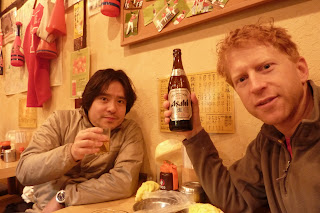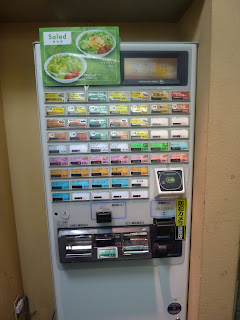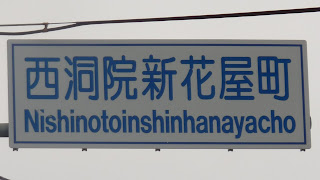
Our flight to Japan landed in Tokyo, so that's where we spent our first few days. We tried to continue with more couch surfing, but believe it or not, in a city of 30 million people we couldn't find someone to take us for the dates we needed, so we booked into a hostel. Tokyo might be big, but it's a small world - what are the odds that on our second night Amanda's friend Luke from the school she studied at while in Germany showed up at our hostel with his friend Nathaniel.

There are 30 million people in Tokyo, and almost a million things to do. For example, walking distance from our hostel is a famous Shinto shrine...

We also visited the very cool Sony building.

This is where they unveil their latest products and we saw some pretty cool things – including their 3D televisions. I even played a 3D PlayStation game on a 3D TV. It was very cool, and if I was 13 years old again it would have been the best thing ever. Understandably, you're not allowed to take photos inside the building.
After all this sight seeing a guy can get hungry, so we opted for some Japanese fast food. This franchise is called Mo's Burger. What makes them unique is the hamburger “bun” is actually made of sticky rice in the shape of bun...

And speaking of fast food and such, how about these...

I don't even know what flavor that's supposed to simulate. What does the Grand Canyon taste like, exactly? I wasn't brave enough to try them. And speaking of brave, who among you would dare to try the intimidating Japanese toilet? Sooner or later you are going to have to use it...

I don't think the toilet on the space shuttle is this sophisticated. Take a look at the toilet control panel

Houston, we have a problem....
Anyway, we also met another friend in Tokyo...

This is Akira, who we met in while in Dahab, Egypt.
We went out for dinner with him a few times, and he showed us some great local spots. Such as a “stand up” restaurant. To pack more people in they don't put out chairs. It's kind of like eating at a stand up bar. He also took us to a restaurant that saves money by having no waitresses. Instead you put money into a vending machine and push buttons for the items you want. For each selection a ticket is produced which you had to the kitchen staff (just as a waitress would do). So here's what a digital waitress looks like:

With so many people, it should be no surprise that Tokyo is also home to the world's busiest intersection. The traffic lights even have a sequence for pedestrians to rule the intersection (no cars for 60 seconds). They call this doing the “Shibuya shuffle”.
One thing I was very much looking forward to in visiting Japan was the food. I love Japanese food – probably more than any other type. And I was not disappointed. Number one on the list is sushi (maki, sashimi, shusi, it's all good). Here's something that some of you may not have seen before – it's a restaurant with a sushi train...

You don't pick items off a menu and make an order. Instead Sushi chefs prepare small plates (usually two pieces) and put them on a moving track that circles around the restaurant. If you see a plate coming by that looks delicious to you, pick it up and it's yours. When you're done a waitress will count how many plates you have and different color plates have a different price code.

This was what our pile looked like after one particularly delicious evening. I'd like to say most of those plates belong to Amanda ;-)
And you probably think sushi is raw fish – but sometimes it is cooked. Here's a chef “cooking” a piece to get just the right taste

Yup – those are two hand held propane bottles he's using. Not exactly haute cuisine, but what do I know?
And who could resist a little sake with that? The sake shops are as plentiful as the selection...

Continuing in Tokyo we went to an eight story toy store. I had some fun playing on the race car track. And this was no kids game – it seemed to be adults only playing the track. And these guys take it seriously, and they're good. I kept spinning out, but they could drive their cars perfectly. Here's me giving it a go...

Later that night we went to see that icon of Japanese film – the statue of Godzilla. It was kind of funny actually, in that it took us quite a while to find it. I had assumed that any statue to a giant fire breathing dinosaur would be gigantic. We must have walked past it four times before I finally spotted this diminutive replica.

We made a visit to Tokyo's famous fashion district where on Sundays the teens like to dress up in their most audacious “fashions” and parade around for the photographers who show up for the spectacle.

Before catching an early morning train south, we went to the very early fish auction in Tokyo. Every day about $15,000,000 USD of fish (the daily catch) is sold auction style. That was pretty fun to watch.


And then we jumped on a plane – no it was a train – a really fast train. Japan's “shinkansen” or bullet train. We took this train south

And once again our world trip took on a more sombre note as we traveled to Nagasaki to see, first hand, one of the cities to be hit by a nuclear weapon. That was at 11:02 am on August 9, 1945, and this is the exact spot where it happened – the hypocenter:

Well, actually, the bomb, named “Fat Man”, was detonated about 600 m above this spot, in order to achieve maximum blast damage. And in that regard it was an absolute success – but I would think of this as one of mankind's greatest failures. This is what it did to Nagasaki on that day...


Following the initial effects of the pressure blast and heat wave, any survivors received a huge dose of radiation and within a week their hair and teeth started to fall out and before long they developed many types of cancer and died slowly and painfully.
Here is what Fat Man looked like (cut away view)

and those were the effects from just 2% of its 16 kg of plutonium going critical. Imagine just 2% of 16 kg - do that math – that's just 320 grams! And this was one of the world's first nuclear weapons. Following this, the H-bomb was developed which is intrinsically about 2,500 times more powerful. In other words, it would have taken just 0.1 grams of H-bomb fuel going critical to cause this same destruction.
At the museum we learned that while only two nuclear weapons have ever been detonated in war, there have been well over 2,000 experimental detonations to improve upon the weapon's technology. How much is enough???
With that darker side of Japan's history seen, we could once again focus on more enjoyable things. So we went a little further to the town of Oita and met up with friends we'd met in Edmonton some years ago – Katsunari, Yumi, and their family (Shinji, and Yume).

After three days enjoying time with the family we went to Osaka. Its most famous site is the Osaka castle – site of a major civil war in 1650.

Japan's cultural center, Kyoto, was our next destination where we saw Japan's ichi ban (number one) tourist attraction, the golden temple

What else is Kyoto famous for? More temples. There were millions of them.

But we were also fortunate enough to be visiting a temple on a Saturday when a very brief (like five minutes) wedding ceremony took place right before our eyes. I got lucky with this great shot of the new couple...

Finding our way around was not problem – sometimes the street names are even written in English, so you can just say the street name to someone when asking directions...

Don't be intimidated – it is pronounced just like it's spelled! So armed with that and the easy to navigate Tokyo metro network, it was no sweat getting around:

Japan has some other interesting traits – some of which arise from the crowded cities where space is valuable. In some cases your space is too small...

Or maybe his car is just too big. Either way, it doesn't quite fit.
Our next flight departed from Tokyo, so we returned there for our final few days. En route we passed Mt. Fuji. That was cool to see.

We tried a sleep in one of the many “capsule” hotels. This is a hotel very much like a vending machine. You put your money (about 30 CAD) into a machine and it prints out a ticket and you get a key with a capsule number. There you will find a room with rows and stacks of things like coffins. One coffin (or capsule) per person. It's definitely long enough and is high enough to sit up in. Each capsule has a TV on the ceiling, some lights and a radio and a clock. The bathrooms are at the end of the hall. Males and females are separated onto different floors of the hotel.

Among the last things we did was visit Tokyo's Imperial Palace, which is situated in a giant park right in the center of Tokyo.

They say that at the height of Japan's real estate bubble (the late 1980's) the value of this park's land would have been more expensive than all of California combined!
And that was it – sadly our time in Japan had come to an end. We even had to sacrifice our plans to visit Korea because Japan just had too much to see.




No comments:
Post a Comment